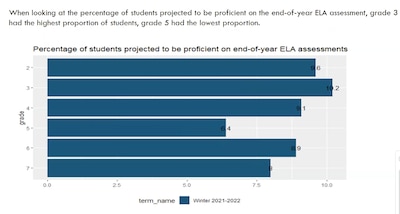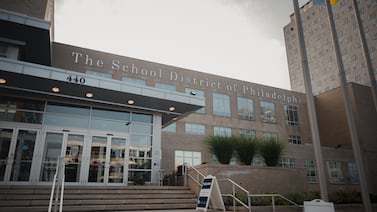Newark students have made scant academic progress so far this school year, according to sobering new test scores that underscore the severity of the pandemic’s toll on student learning and the extraordinary measures that will be required for students to recover.
Based on mid-year assessments, no more than 6% of students in any grade from 3-7 are expected to reach the “proficient” level on the state math tests slated to begin next month, according to data that Newark Public Schools officials shared last week. By contrast, 27% of students in grades 3-8 met the state’s benchmarks on the annual math tests in 2019, before the pandemic shut down schools and drastically curtailed learning.

Reading scores on the mid-year tests, which students in grades 1-7 took in February, were only slightly higher. In each of the tested grades, about 10% of students or fewer are expected to meet state English standards this year, the data show.
Buoyed by an influx of federal aid and students’ long-awaited return to classrooms, Newark officials had hoped this school year would mark the beginning of a sustained comeback. But the latest data suggest that, at least in terms of test scores, students have made up little of the ground they lost during the pandemic.
“It sure doesn’t look like kids are catching up,” said Thomas Kane, an economist at the Harvard Graduate School of Education, who at Chalkbeat’s request reviewed some of the data officials presented at last week’s Newark school board meeting.

The data come from assessments — created by nonprofit testmaker NWEA — that Newark and districts across the country administer throughout the school year to track students’ progress. Newark students will take the NWEA’s MAP Growth tests again in June, which gives schools time to work on raising student achievement.
Stark learning gaps also emerged when Newark students took the same tests in spring 2021, which aligned with national data showing that the pandemic’s disruptions had slowed most students’ academic progress, with students who are Black, Hispanic, or from low-income families falling furthest behind. Kane added that in districts such as Newark, where families have faced incredible hardships during the pandemic and most students spent all of last school year learning remotely, the emerging data suggest the road to recovery will be even steeper than many anticipated.
“I think this is something that most school districts in the country have yet to grapple with: the magnitude of the losses and the scale of the effort that’s going to be required to eliminate those losses,” said Kane, who is working with NWEA to analyze how well schools’ academic interventions work.
Newark Superintendent Roger León has acknowledged the pandemic’s heavy toll on student learning. Before an official presented the mid-year test scores at the March 22 board meeting, León said the district is “taking the numbers very seriously because their implications are quite profound.”
“The road is long,” he said, referring to students’ academic recovery.
Newark’s results on the most recent NWEA tests were in line with national trends in the fall: Students struggled most in math, and students in the upper grades outperformed younger students.

The tests, which Newark students took in October and February, also showed that few students improved their scores as much during that period as would be expected in a typical school year.
In math, just 6.4% of second graders and about 20% of seventh graders made the expected amount of progress from fall to winter. In reading, the percentage of students who met growth projections ranged from 10% of first graders to about 22% of seventh graders.

The projections are based on the amount of progress that similar students typically made prior to the pandemic. The estimates do not take into account the severe disruptions that have slowed learning over the past two years.
The Newark school district, which is set to receive more than $282 million in COVID relief money from the federal government, has taken several steps to jump-start students’ recovery. The district expanded summer school and tutoring programs, ramped up teacher training, and hired additional specialists to work individually with students, officials have said. Schools also added more mental health services and lessons on managing emotions, which educators say students need in order to learn at full capacity.
At an event Tuesday celebrating Newark’s recovery efforts, educator Janice Litterio said the federal funds helped the district enroll more students in its afterschool programs and revamp the curriculum so it connects to what students learn in class.
“We have seen much success with that,” said Litterio, an academic interventionist at First Avenue School who manages the afterschool programs at several schools.
Yet Newark, which is New Jersey’s largest district with about 38,000 students, has encountered many of the same obstacles that are frustrating schools nationwide and dampening hopes for a return to normalcy this school year, much less the above-average pace of progress that experts say will be needed to counter pandemic learning loss.
After in-person learning resumed in September, a surge in COVID cases late last year kept hundreds of students and employees out of school and forced the district to temporarily revert to remote learning in January. Even after classrooms reopened, more than 35% of students were chronically absent in February, according to district data.
At the same time, Newark has struggled to hire enough teachers and other educators, as districts nationwide contend with staffing shortages. León said Tuesday that the district has 115 instructional openings, nearly as many unfilled positions as it started the year with, forcing teachers to take on extra classes and administrators to become stand-in teachers.
Meanwhile, as many students process distressing or traumatic experiences during the pandemic such as housing insecurity or the loss of loved ones, some are having trouble readjusting to school. During a recent interview, León said “students are exhibiting behaviors unlike ever before,” which he called a matter “of great concern.”
Like other large districts, Newark is relying on voluntary programs such as after-school tutoring and summer school to catch students up. That approach avoids some of the challenges of universal programs, such a longer school day or year, which cost more and would likely require labor negotiations. But it also excludes students who don’t opt in.
In October, the district’s afterschool programs only served some 3,800 elementary school students per day, or about 16% of that population, according to district documents. León has said some schools also offer tutoring during the day, but it is unclear whether it is the “high-dosage” tutoring, with multiple small-group sessions per week, that federal officials have called for and research shows is most effective.
Wilhelmina Holder, the grandparent of several district students who heads the Secondary Parents Council, an advocacy group for the parents of high schoolers, said the district should share more information about its recovery efforts.
“How many kids are actually participating?” she asked. “We know what they say they’re doing, but what does that look like for students?”
Whatever form the academic support takes, she added, the latest data shows that it’s urgently needed.
“There’s a whole lot at stake here,” she said.








